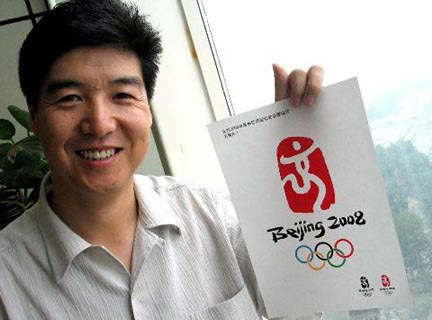One year after Beijing won the rights to host the Games, organizers launched a contest in a bid to find a special logo for China's largest public event.
Seasoned advertising man, Guo Chunning, beat 1,300 other professionals with his entry - a powerful seal, which drew from history and reflected China's modern progress.

Guo Chunning shows his design of Chinese Seal of the Beijing Olympics.
Seal cutting is a time-honored art among the literati and dates back to the Spring and Autumn Period (770-476 BC). The Chinese character for a seal is composed of two words: zhua, which means hand, and jie, a tally issued by a ruler to generals or envoys as credentials.
Originally, dukes and princes handed a tally to their trustees to perform a difficult mission. The seal stood for conferment, responsibility and obligation.
As a symbol for trust and promise, a seal paves the way for clear communication and authenticity of the message.
Chinese believe winning the 2008 bid represented both the trust of the Olympic family as well as a promise made on behalf of the 1.3 billion Chinese people.
On July 13, 2001, the Beijing delegation solemnly proclaimed in Moscow that China would go all out to make the 2008 Olympic Games a phenomenal success.
The unique seal serves as a testimony that "for the world's good faith in us, we shall requite with success and honor".
A Chinese seal is always red, which also symbolizes the burning Olympic flame.
For millenniums, red has been the color for supreme happiness, widely used for grand or blissful occasions. This auspicious color was chosen for the national flag when the People's Republic of China was established in 1949.
A seal was also part of a Chinese scholar's standard paraphernalia.
As an art form, seal cutting imposes exact demands upon scholar-artists, in terms of calligraphy, layout and line.
One's work must be rich in flavor, grand and lofty in taste, effortless in craftsmanship, and most important of all, the work should in itself be rich with meaning.
The 2008 emblem is an amazing enigma for connoisseurs and veterans.
For one thing, it looks like the Chinese character of wen, short for wenhua, which means culture or civilization.
As one of the world's ancient civilizations, China contributes a rich legacy of sports.
Qigong and martial arts are but two of the most well-known varieties. Modern archery, shooting and skiing have evidently evolved from ancient Chinese recreation and sports.
The Olympic seal also resembles the Chinese character jing, which means Beijing, a city that has thousands of years of history.
From a different angle, one can also see a girl dancing with a red silk ribbon. She is full of youthful vigor and feminine grace and is welcoming guests and athletes from all over the world.
Another reading reveals a human figure sprinting to the finish line. He is celebrating Olympic athleticism and is the flower of life in full blossom. He is growing tall in the bright Olympic sun.
The designer finally chisels the English word "Beijing", and the Arabic figures "2008" together in archaic calligraphy styles.
(China Daily July 7, 2008)